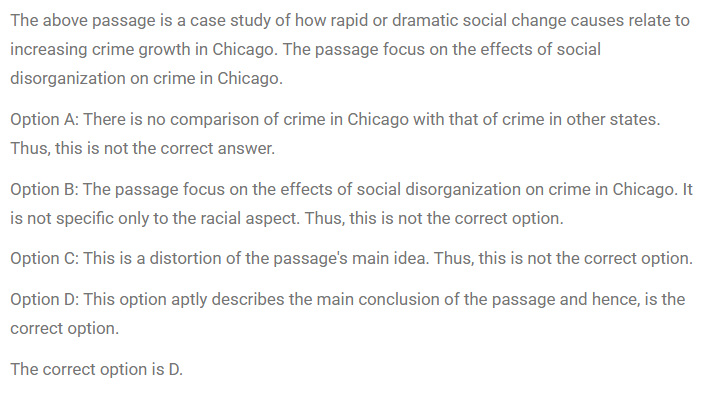CAT RC Questions | CAT RC- Social Science questions
FundaMakers is the Best CAT Online Coaching In India. Now prepare for CAT anytime with FundaMakers. We provide well-ordered syllabus coverage for both offline and online CAT preparation batches. FundaMakers brings to you the power-packed, well-structured CAT previous year question bank with more than 4000+ CAT Past Year questions. In the VARC section, one of the most frequently asked questions is from the topic- Reading Comprehension. Reading Comprehension turns out to be an important part of the VARC section from which over 60-70% of the questions are based on RC in the CAT Exam.
FundaMakers as a team has taken a painstaking step to bring you all the video solutions of the Reading Comprehension asked in the Previous Year CAT exam. CAT question bank offered by FundaMakers is a power-packed topic-wise compilation of the entire CAT previous year questions. Questions from the Reading Comprehension topic are some of the most scoring questions in the VARC section. To maximize your CAT score make use of FundaMakers CAT Question Bank. “Questions from CAT previous years” examination papers have been incorporated. Let’s get started with CAT Past Year Reading Comprehension Questions.
Comprehension
The passage below is accompanied by a set of questions. Choose the best answer to each question.
Sociologists working in the Chicago School tradition have focused on how rapid or dramatic social change causes increases in crime. Just as Durkheim, Marx, Toennies, and other European sociologists thought that the rapid changes produced by industrialization and urbanization produced crime and disorder, so too did the Chicago School theorists. The location of the University of Chicago provided an excellent opportunity for Park, Burgess, and McKenzie to study the social ecology of the city. Shaw and McKay found . . . that areas of the city characterized by high levels of social disorganization had higher rates of crime and delinquency. In the 1920s and 1930s Chicago, like many American cities, experienced considerable immigration. Rapid population growth is a disorganizing influence, but growth resulting from in-migration of very different people is particularly disruptive. Chicago’s in-migrants were both native-born whites and blacks from rural areas and small towns, and foreign immigrants. The heavy industry of cities like Chicago, Detroit, and Pittsburgh drew those seeking opportunities and new lives. Farmers and villagers from America’s hinterland, like their European cousins of whom Durkheim wrote, moved in large numbers into cities. At the start of the twentieth century, Americans were predominately a rural population, but by the century’s mid-point most lived in urban areas. The social lives of these migrants, as well as those already living in the cities they moved to, were disrupted by the differences between urban and rural life. According to social disorganization theory, until the social ecology of the ‘‘new place’’ can adapt, this rapid change is a criminogenic influence. But most rural migrants, and even many of the foreign immigrants to the city, looked like and eventually spoke the same language as the natives of the cities into which they moved. These similarities allowed for more rapid social integration for these migrants than was the case for African Americans and most foreign immigrants. In these same decades America experienced what has been called ‘‘the great migration’’: the massive movement of African Americans out of the rural South and into northern (and some southern) cities. The scale of this migration is one of the most dramatic in human history. These migrants, unlike their white counterparts, were not integrated into the cities they now called home. In fact, most American cities at the end of the twentieth century were characterized by high levels of racial residential segregation . . . Failure to integrate these migrants, coupled with other forces of social disorganization such as crowding, poverty, and illness, caused crime rates to climb in the cities, particularly in the segregated wards and neighborhoods where the migrants were forced to live. Foreign immigrants during this period did not look as dramatically different from the rest of the population as blacks did, but the migrants from eastern and southern Europe who came to American cities did not speak English, and were frequently Catholic, while the native born were mostly Protestant. The combination of rapid population growth with the diversity of those moving into the cities created what the Chicago School sociologists called social disorganization.
Explanatory Answer
Method of solving this CAT RC Question from RC- Social Science question
Correct Option: D

Hey!
Worried about IIM calls due to your marks in 10th,12th, and Graduation?
Don't worry! Know your chances of getting an IIM Call based on your profile with our:-
Profile Professor: https://fundamakers.com/profile-professor/

5 Must- NOT-Dos during CAT Preparation.
- Do not treat CAT as 'Everything'.
- Do not quit your job for CAT exam preparation.
- Learning till The Eleventh hour instead of doing proper revision.
- Not checking the syllabus thoroughly.
- Piling up multiple books.
Click To Read:- Common mistakes made by CAT aspirants during preparation.
FundaMakers- Best Online and Offline CAT Online Preparation Institute in India
For any CAT Preparation related query, reach out to us at 9598333344.